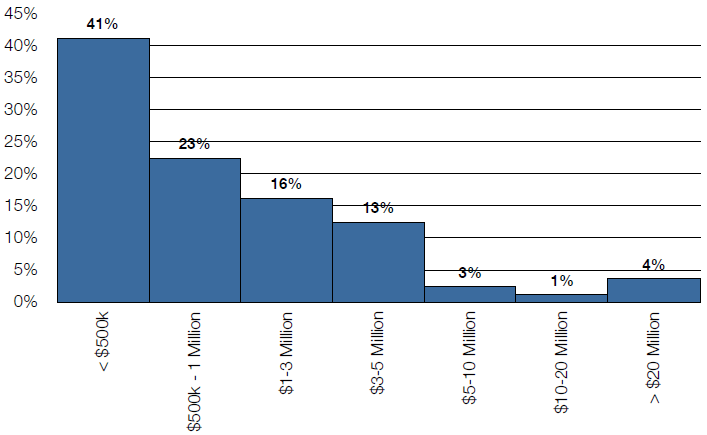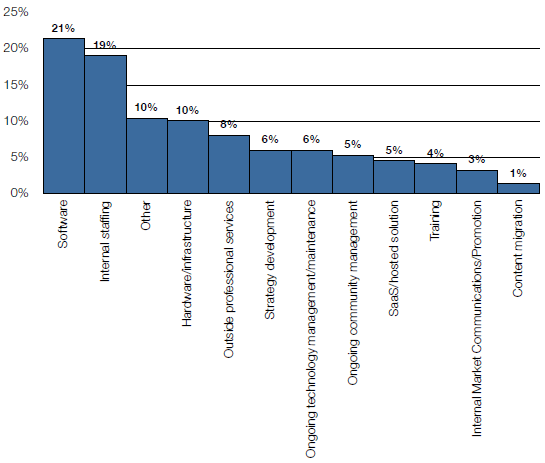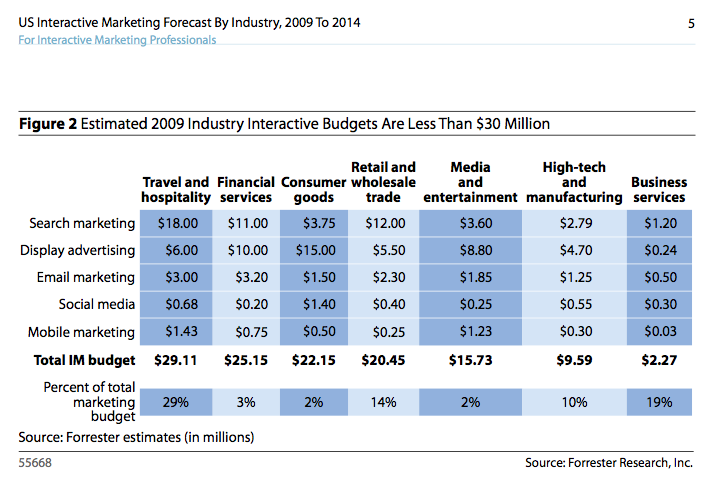A few posts ago I talked about Enterprise 2.0 Adoption where I reviewed a portion of a report that was released by the Enterprise 2.0 council. Recently, the FULL report was released online for free which provides more insight into how companies are beginning to adopt and implement Enterprise 2.0. You can find the full Enterprise 2.0 report for free here (thanks to the Enterprise 2.0 Council). I highly recommend you read the full report but I want to focus on what I believe is the most important section which is where companies are allocating their dollars. The two graphs below provide a budget breakdown of what Enterprise 2.0 budgets are and what those budgets are going towards.


Pay special attention to the fact that almost all Enterprise 2.0 budgets are under 3 million dollars (with a majority being under 1 million). Notice that only 6% of the total Enterprise 2.0 budget is going towards developing a strategy. Taking the numbers from above means that:
- 41% of companies are spending $30,000 or LESS on their Enterprise 2.0 strategy
- 23% of companies are spending between $30,000-$60,000 on their Enterprise 2.0 strategy
- 16% of companies are spending between $60,000-$180,000 on their Enterprise 2.0 strategy
- 13% of companies are spending between $180,000-$300,000 on their Enterprise 2.0 strategy
- 8% of companies are spending upwards of $300,000 on their Enterprise 2.0 strategy
Strategy is tied for 6th place along with “ongoing technology management/maintenance” and ranks juts slightly higher than community management and training, why? The strategy is going to be the backbone of the entire Enterprise 2.0 initiative and while the budgeting breakdown above doesn’t signal priority of spending (otherwise we would be in BIG trouble) it does raise the question of what companies are doing and expecting from a budget that is oftentimes under $60,000? This is part of the reason why I asked the question, “Is Enterprise 2.0 a Crock?”
I realize that we are still in the early adopter stages of social media, social business, enterprise 2.0, or whatever else you want to call it but I think we need to do a better job at allocating budgets towards Enterprise 2.0 shifts. Why can companies justify hundreds of thousands of dollars on software and staffing but not on developing the strategies that support that? Something doesn’t make sense here and I think we need to rethink how we are approaching this.
Think about that while you look at the graph below which is from Forrester and provides estimated interactive budgets for various companies during 2009.

Notice one key distinction, the Forrester budgeting specifies “social media” in the estimates but does not mention “enterprise 2.0” so I’m making the assumption that these are 2 separate things. This means that companies have no problem spending between $200,000-$1.4 million on social media (which is external facing) but are not spending anywhere near that amount on Enterprise 2.0 (internal facing).
What we need to realize is that both internal and external social business efforts need to work in tandem to achieve the greatest results. How can brands justify spending on building external communities when they are still struggling with building internal collaboration communities.
2010 is going to see drastic changes in the Enterprise 2.0 space both in terms of adoption and in how budgets are being allocated (or at least I hope it will see changes)

Jacob, this is a fantastic piece. I think there are two very important implications here.
1. Strategy Development: As of yet, no widely adopted system of social media measurement exists. It's difficult for companies to set true strategy on insight and trend analysis alone. Performance needs to be measured and correlated to Return On Investment before the C-Suite can begin to adopt the technology as a holistic, strategy-driving force.
2. Software spending vs internal staffing: Expertise is not wide-spread or uniformly recognized in the space. This leads companies, often driven by F.U.D. (fear, uncertainty, doubt), to the realization that while they know they need to engage (more externally than internally), there's no clear path forward. Companies with the resources are content to let solutions developed by category purveyors act as their stop-gap measure, while companies who are streamlining budgets are adding responsibility to already stretched staff. I think, at the moment, we're seeing companies do just enough to sleep well, without wholehearted adoption.
As a industry, we've yet crack the code that will make SM an operational necessity.
Our founder, Wendy Troupe, did an interesting blog on the top 10 ways SM will change companies both internally and externally. If you'll permit me, here's the link: http://bit.ly/4oLfYp I think this might be an interesting companion piece to this post.
I enjoyed reading this… very well thought out!
Thanks for this excellent post! I will for sure read the whole report.
In my opinion the development of budgets for new tools for internal facing and external facing as you call it, follow a historical trend. It's always been easier to justify to spend 100k on a marketing campaign that may bring new customers than to spend 10k on an internal tool that makes for example team collaboration more efficient.
Thanks Matt,
I actually just responded to the two blog posts you pointed me too. I don't think we are really going to see a widely adopted system of measurement anytime soon. In terms of Enterprise 2.0 activity we're going to be looking at things like increase productivity, decrease costs, etc. There is also a lot of ad-hoc ROI that we are going to see as well. What I mean by this is say that a company deploys an internal collaboration tool and everything stays the same across the board, then all of a sudden after 6 months someone shares a cost saving technique that can save money across the board. There's no way to really predict or put a value on information.
When you talk about SM are you talking internal or external use? I think we have seen a lot of great case studies and examples from companies using both internally and externally. I don't think we need to crack a code I think it's just going to be a natural evolution of business.
Thanks for the comment. I agree with what you're saying event though these internal tools themselves are going to cost well into the 6 figures we're talking about anything from 150-700k+ depending on the size of the organization, and that's not including a strategy.
thanks, glad you enjoyed it!
Hi Jacob. I've been trying to get to this post since I saw it. You make a great case for strategy consulting and I'm certain all my e20 guru friends are now subscribing to your blog… 🙂
However, be very careful with these numbers in absolute terms. When we did the study, many of our members were still planning. For instance, one member who took the study answered his budget was less than $500K because they were still fleshing out their enterprise plans. In the past week, his team presented to the CEO and the CEO's direct reports and got approval for a budget 10x that amount for the full roll out. Although, admittedly, very few of our members consulted outside strategic counsel for their initiatives. There is an element of truth to the “snake oil” post Stephen Baker wrote last week. The market is still in its infancy, so it will be a long time before we see big budgets allocated toward strategic planning for e20.
Hi Susan. Thanks for the kind words and glad that you got some folks to subscribe here!
You make a very good point there and it's definitely something to take into consideration. Have you been able to get some information from companies as to weather they are developing strategies internally or seeking outside support?
On a side note, how can I get more involved with the E2.0 Council? I'll actually email you 🙂
Hi Jacob. I've been trying to get to this post since I saw it. You make a great case for strategy consulting and I'm certain all my e20 guru friends are now subscribing to your blog… 🙂
However, be very careful with these numbers in absolute terms. When we did the study, many of our members were still planning. For instance, one member who took the study answered his budget was less than $500K because they were still fleshing out their enterprise plans. In the past week, his team presented to the CEO and the CEO's direct reports and got approval for a budget 10x that amount for the full roll out. Although, admittedly, very few of our members consulted outside strategic counsel for their initiatives. There is an element of truth to the “snake oil” post Stephen Baker wrote last week. The market is still in its infancy, so it will be a long time before we see big budgets allocated toward strategic planning for e20.
Hi Susan. Thanks for the kind words and glad that you got some folks to subscribe here!
You make a very good point there and it's definitely something to take into consideration. Have you been able to get some information from companies as to weather they are developing strategies internally or seeking outside support?
On a side note, how can I get more involved with the E2.0 Council? I'll actually email you 🙂
Pingback: What is Enterprise 2.0? The Basics
Pingback: Lessons Learned from Cubetree; an Enterprise Social Software Company
hi jacob. this totally ties in with our emphasis lately. enterprise 2.0 or collaboration technology is more than just allowing you to share that document. it has major long term strategic implications, and that is how it should be approached. my blog post about this –
http://www.hyperoffice.com/blog/2012/01/27/1437/